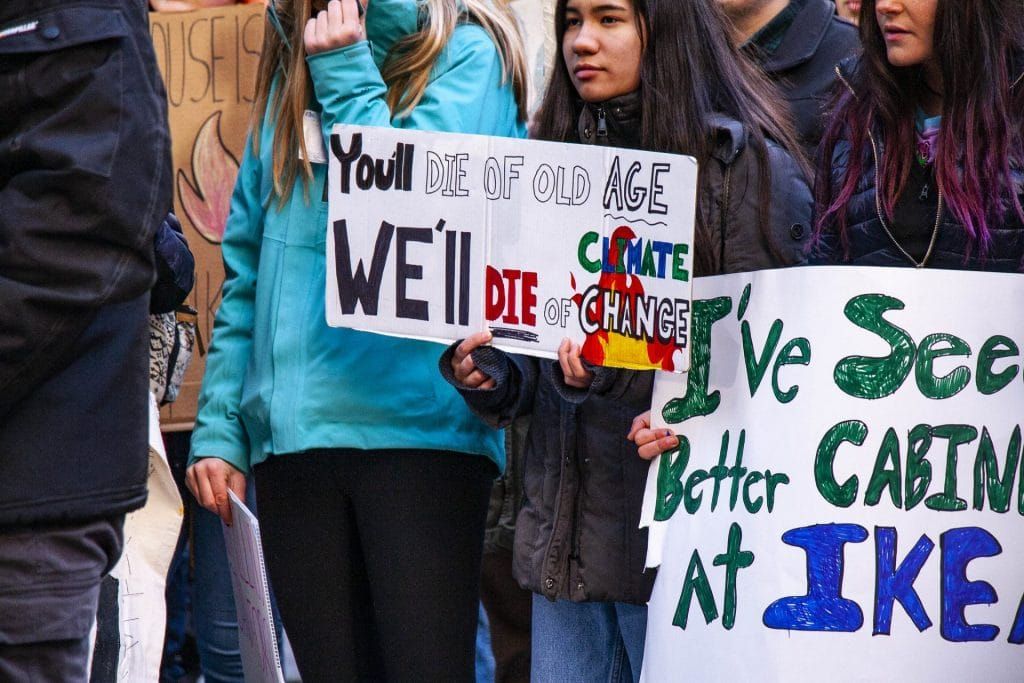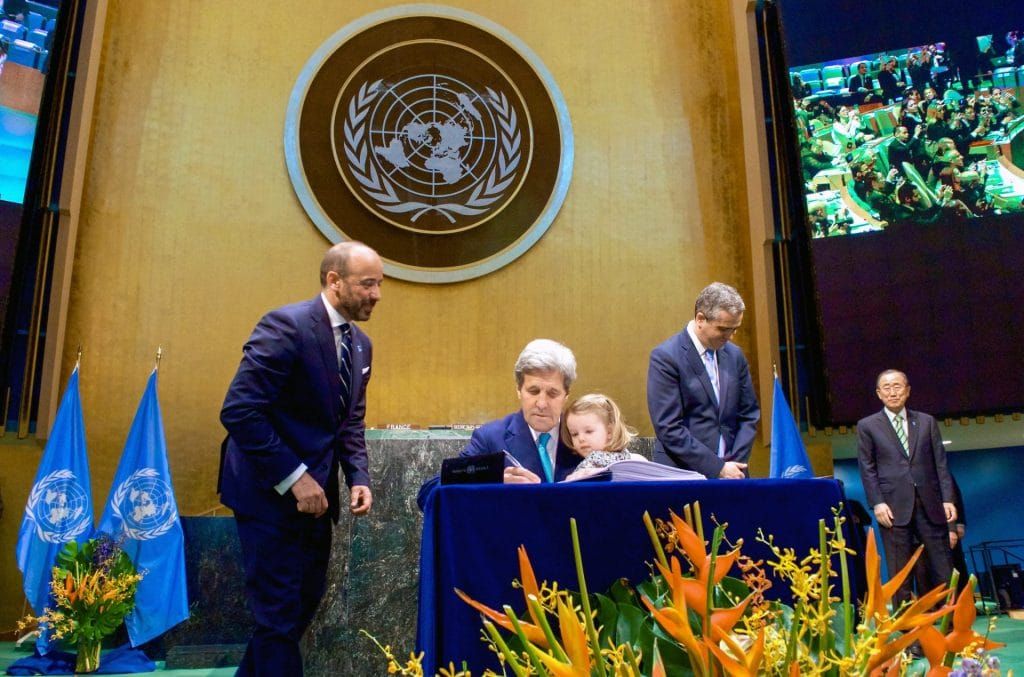Fed up: High stakes but lower hopes in run-up to COP26
By John Morales | October 29, 2021
 Photo by Charles Edward Miller/Flickr
Photo by Charles Edward Miller/Flickr
Julieta Rodrigo is ready for a dogfight in Glasgow.
“We are fed up with inaction,” she told me. “We’re the generations that are going to inherit this really vulnerable and volatile world, and nobody is taking the leadership that we need to see at the scale that we need to see it.”
Rodrigo is a program manager at The CLEO Institute, a Florida-based organization whose mission is to “educate and empower communities to demand climate action, ensuring a safe, just, and healthy environment for all.” For Rodrigo’s millennial generation—she is 27—there is too much at stake as the 26th Conference of Parties (COP26), organized by the United Nations Framework Convention on Climate Change (UNFCCC), gets underway in Glasgow. She will be at the conference representing CLEO with high hopes, but also trepidation.

“I’m hopeful that it’s going to go the way it needs to,” she said. “But then you also have the reality that there are a lot of lobbyists, there are a lot of powerful influences, and a lot of countries that are unwilling to do what it takes. So, there are going to be frustrating conversations. There are going to be very difficult negotiations and some compromises.”
There is concern and great debate over what each country brings to the table in the form of pledges to reduce their greenhouse gas emissions—with an intermediate goal of cutting that type of pollution in half by 2030 and achieving net-zero emissions by 2050. In the aggregate, these nationally determined contributions (NDCs) to the global carbon emissions budget were supposed to put the world on track to avoid warming beyond 1.5 degrees Celsius (2.7 degrees Fahrenheit) above pre-industrial levels. But the sum of all NDCs put forward to this point, plus the carbon footprint of countries that haven’t even bothered to submit an updated pledge, shows that warming emissions will still increase by 2030.
The biggest task at COP26 is to get countries to dig deeper—no pun intended—for carbon-cutting pledges that can keep the planet from blowing by the 1.5-degree target.
Of course, it’s one thing to pledge, and another to deliver. Take the United States.
The US history of climate engagement is decidedly contentious. The United States initially refused to commit to binding greenhouse gas emission reductions during the international community’s first attempt at climate change mitigation—the Kyoto treaty negotiations. In 1997, just a few months before the United States finally agreed to sign the Kyoto Protocol, the US Senate unanimously passed the Byrd-Hagel Resolution, which opposed any international agreement that did not require developing countries to commit to legally binding greenhouse pollution reductions if developed countries did. Byrd-Hagel and Republican obstruction—peculiarities that the United States is infamous for on the world stage—are largely to blame for the non-binding and non-punitive characteristics of the Paris climate agreements.
This makes COP26 even more important, because a firmer roadmap to achieving emissions reductions still needs to be formulated a full six years after the Paris accord was completed.
“The whole world is going to be looking at the United States’ leadership,” says Rodrigo. After four years of a Trump administration in which climate was deprioritized, culminating in the United States pulling out of Paris altogether, the country must prove that it can step up as a global leader on climate action. For COP26, the Americans are bringing a tour-de-force delegation to Glasgow, including President Biden and 13 of his cabinet members.
Despite the well-stocked American delegation, if what survives of the Democrats’ Build Back Better infrastructure bill if and when it passes does not include robust climate change mitigation proposals, the United States could arrive in Glasgow as a hollow shell. US climate envoy John Kerry alarmingly framed it as “pulling out of the Paris agreement, again.”

Coal-state West Virginia Sen. Joe Manchin, a Democrat, is (with an assist from Democratic Sen. Kristen Sinema from Arizona) putting the US climate plan at risk of collapse. Ironically, recently-released data shows that West Virginia ranks first in the contiguous United States in infrastructure exposed to worsening floods—one of the symptoms of global warming.
Manchin forced his colleagues to scrap the Clean Electricity Performance Program (CEPP), dubbed the “backbone of the energy transition.” The measure, part of the Build Back Better Act infrastructure bill, would have provided incentives for power producers to switch from burning coal and natural gas to clean power sources like solar, wind and nuclear. It was to cost $150 billion, or just 4 percent of the $3.5 trillion infrastructure bill originally proposed. (The current plan costs just $1.85 trillion, after Manchin and Sinema’s cuts.)
While many are incensed at Manchin, it’s important to remember that it’s the unanimous opposition from Senate Republicans that gave the bill such long odds in the first place.
With the CEPP gone from the infrastructure bill and no comparable replacement, Biden appears ready to push for deep cuts to the country’s greenhouse gas emissions anyway. But that so-called Plan B would rely heavily on executive orders and regulatory agency rule enforcement—measures that can be challenged in courts or reversed by future presidential administrations.
Even if the Americans show up in Glasgow with a credible set of commitments that can spark other nations to make deeper cuts in emissions, there are still significant hurdles to overcome at COP26—principally that China and India have yet to submit updated NDCs. Plus, as with all UN proceedings, a consensus will need to be reached before any language is formally adopted.
In many ways, COP has become a first-versus-third world conflict—with the developing world often carrying significant clout.
Still-industrializing countries claim that they must continue to use fossil fuels to approach the economic growth already realized by the Global North, or industrialized countries. The Global South, therefore, demands financial support to adopt green energy practices that, while trending cheaper, are still often more expensive than burning coal, oil, and gas. Give-or-get contributions from rich countries for climate finance have so far failed to reach previously set targets.
With extreme heat, drought, floods, cyclones, and surging seas unrelentingly accelerating, developing countries will also need more funds to adapt to the worsening impacts of the changing climate. As Rodrigo reiterated, “Those least contributing to the climate crisis are those that are most at risk.”
There is also tension over who should pay for the damage from increasingly frequent and severe natural disasters driven by global warming, which disproportionately impact the Third World even though climate change has been primarily caused by rich nations like the United States. “We have to take responsibility for our role in this,” Rodrigo said.
If this to-do list for COP26 weren’t daunting enough, there are other thorny issues to tackle, including establishing rules for international carbon markets and agreeing on what time periods NDCs should cover—is it net zero by 2050 or 2060? Yes, that is still up in the air.
There is also the aspirational goal of getting countries to keep fossil fuels in the ground, with coal being the easiest target. South Korea, Japan, and China already agreed to stop funding coal plant development in other countries. But they continue to consume it themselves. As does the United States, which is still drilling for oil and fracking for methane at an alarming pace. In fact, the United States is poised to become the largest global exporter of liquified natural gas by 2023, and President Biden recently called on OPEC to increase oil production in an attempt to keep fuel prices down. Is that the kind of leadership on climate the world is looking for?
“We have a lot of promises from elected officials that ultimately turn out to be greenwashing—and it hurts!” Rodrigo complained. “It sucks, especially when you know it’s coming from people that have the capacity to do more and do better.”
To be fair, Biden is doing better. And it could be argued that keeping gas prices down (in gas-priced-obsessed America) with OPEC’s help ultimately helps Democrats stay in office longer to enact stronger actions to cool the planet.
But the patience of younger generations is wearing thin. “Young delegates are going to be tracking every movement [at the conference],” says Rodrigo. “We’re expecting a lot of protests.”
Ultimately, the climate crisis impacts everyone—those alive today as well as generations to come. Many, like me, were part of the problem. (As a Baby Boomer, I grew up in an era in which consumption and waste were seldom frowned upon.) Others, like my 4-year-old grandson, are not at all at fault.
It is Gens Y and Z that have become leaders in the social movement to demand action to stave off the climate crisis. Rodrigo explained why: “We owe it to ourselves, we owe it to our peers, we owe it to our families, our community members, the people who are unaware of what the challenge is and don’t have a voice to protect themselves. We owe it to them to be leaders in this movement.”
Together, we make the world safer.
The Bulletin elevates expert voices above the noise. But as an independent nonprofit organization, our operations depend on the support of readers like you. Help us continue to deliver quality journalism that holds leaders accountable. Your support of our work at any level is important. In return, we promise our coverage will be understandable, influential, vigilant, solution-oriented, and fair-minded. Together we can make a difference.
Keywords: COP26, Glasgow, Paris climate agreement, climate change, climate crisis, climate negotiations, climate summit, youth activists
Topics: Climate Change















Bien interesante cómo expones la presente situación re cambio climático y sus efectos negativos vs lo que estamos haciendo de verdad!!!